Definition leaf
A leaf is a lateral, dissimilar appendage of the stem, growing at a node and subtending a bud in its axil. It is a partial stem or branch with limited growth. Typically green and flattened, the leaf is the most crucial vegetative part of the plant, as it is where food is produced. Leaves originate from the swollen exogenous protuberances at the growing apex, known as leaf primordia, and develop in an acropetal order.
Types of leaves
According to the origin and function of leaves, they can be grouped into following types:
- Cotyledonary leaves or seed leaves: These are embryonic leaves found in seeds. They can be fleshy due to stored food, such as in beans and grams, or thin and flat with vein markings, like in castor (Ricinus communis).
- Cataphylls or scale leaves: These small, sessile, non-green leaves are dry and papery or sometimes fleshy. They can appear on aerial parts, as seen in bamboo, Casuarina, and Asparagus. Each scale leaf has a bud in its axil, protecting the young bud or storing food in plants like onion and garlic.
- Hypsophylls or bract leaves: These special leaves hold flowers or inflorescences in their axils. Typically small and green, they can be large and brightly colored in plants like Bougainvillea and Euphorbia to attract insects. They protect flower buds.
- Prophylls: The first few leaves on a stem that differ from other leaves are termed prophylls. Typically, monocots have one prophyll, while dicots have two. In wood apple (Aegle marmelos), prophylls are represented by spines.
- Floral leaves and sporophylls: These are specialized leaves found in flowers, including sepals, petals, tepals, stamens, and carpels. Stamens and carpels are also known as sporophylls. Sepals are green and protective, while petals are colorful and attractive. Stamens and carpels are involved in sexual reproduction.
- Foliage leaves: These are the common green leaves attached to the aerial stem and branches, primarily responsible for photosynthesis.
Also Read: Root

Cotyledonary leaves of Ricinus Cataphylls of Asparargus Hypsophylls of Bougainvillea
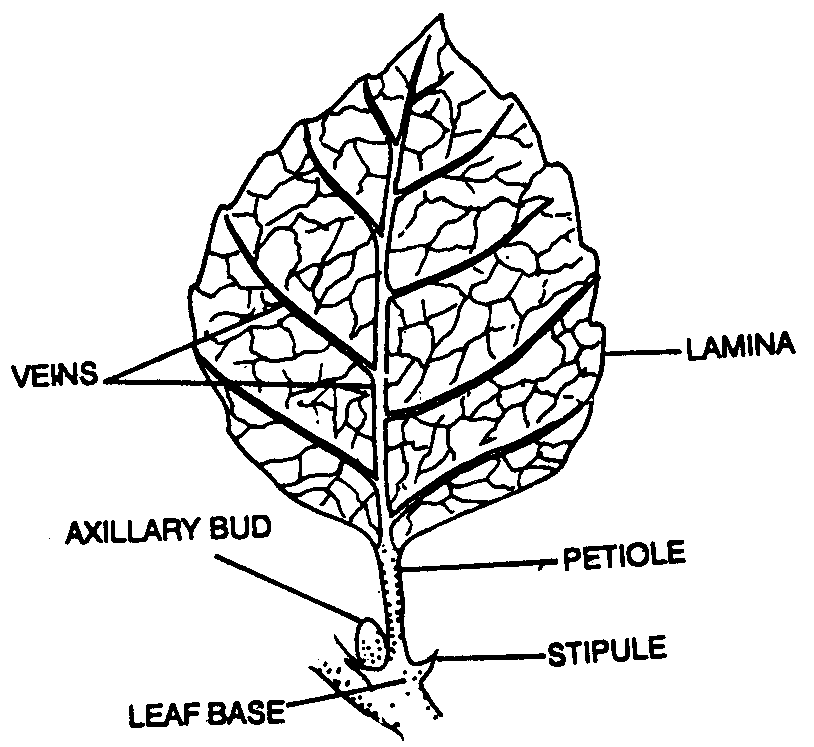
Parts of a typical foliage leaf
A typical foliage leaf has got three parts: Hypopodium or leaf base, Mesopodium or petiole, Epipodium or leaf lamina or blade
LEAF BASE (Hypopodium)
It is the point of attachment of the leaf to the stem. It is a prolongation of the tissue of the stem. There are following types of leaf bases:
- Pulvinous: The swollen leaf base is known as pulvinous. Its attachment on the stem is weak and hence leaves with such leaf bases can be plucked easily e.g., mango, pea, gram, beans, shy plant, banyan tree, gulmohar, etc.
- Sheathing: In most monocots and in a few dicots the leaf base commonly expands into a sheath. The sheathing leaf base may clasp and surround the stem completely, called amplexicaul (e.g., grasses, Polygonum) or incompletely, called semi-amplexicaul (e.g., coriander, palms, buttercup, etc.). The sheathing leaf base of grasses possess a small leaf-like outgrowth called ligule just below the lamina. The leaf with ligule is called as ligulate.
Also Read: Soil
In banana sheathing leaf bases form a pseudostem or false stem while the actual stem is below the ground.
The leaf-base frequently bears a pair of lateral appendages called stipules. A leaf with stipules is called stipulate and that without stipules is called exstipulate.
PETIOLE (Mesopodium)
It is the stalk of the leaf. It connects the lamina with the branch or stem. Its upper portion continues in the lamina forming midrib or costa while lower portion forms the leaf base. When the petiole is absent, the leaf is said to be sessile (e.g., wheat, rice, Calotropis, Gloriosa, etc.) and when present, it is said to be petiolate or stalked (e.g., mango, peepal. guava, cotton, China rose, etc.). When the petiole is short, the leaf is called subsessile. A long petiole raises lamina high to get more light and air. Commonly the petiole is cylindrical with a long groove on upper surface. The petiole is swollen in Eichhornia and winged in Citrus.
LAMINA (Epipodium)
It is the most important part of the leaf and is the seat of gaseous interchange, starch formation and so on. The part of petiole which enters into lamina is called mid rib or costa. It extends from base to the tip of lamina and divides it into two halves. The mid rib gives out lateral branches, called primary veins, which in turn divide repeatedly and form a network of veinlets throughout lamina. A lamina has two surfaces, adaxial or upper and abaxial or lower. Veins are prominent over the abaxial surface which is, therefore, also called dorsal or outer surface. Corresponding adaxial surface is referred to as ventral or inner surface.
Also Check: What is an Ecosystem?
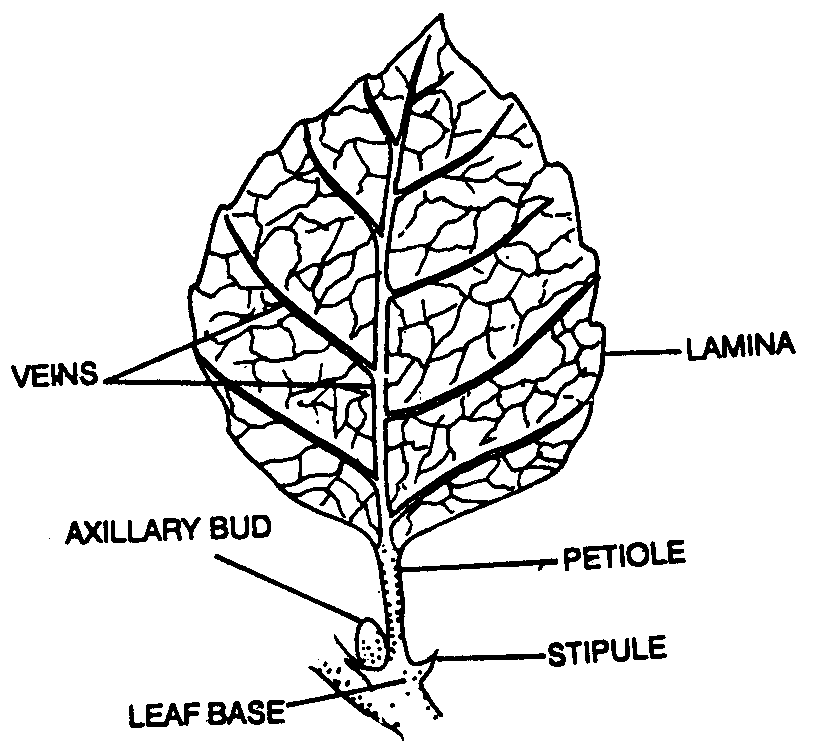
Fig. Parts of a typical leaf
Stipules
Stipules are small, green, lateral appendages borne behind the leaf at its base. Their function is to protect young leaves and to manufacture food. While they are very common in dicots, they are rather rare among the monocots.
Types of Stipules
According to longevity (duration), stipules may be of three types:
- Caducous: Such stipules fall down before the leaf unfolds, e.g., Michelia champaca, Dipterocarpus scabes, etc.
- Deciduous: Such stipules fall down just after the leaf unfolds, e.g., Cassia tora, Dillenia indica, etc.
- Persistent: Such stipules remain attached throughout life, e.g., rose, China rose, pea. etc.
Also Read: Birth Control
According to their structure and location, stipules may be of following types:
- Free lateral: These stipules are of the simplest type. These are two, small, green, soft, filiform stipules borne on both sides of the leaf base, e.g.. China rose, cotton. etc.
- Adnate: These are two lateral stipules attached to the petiole with their posterior part so that the base of petiole appears to be winged, e.g., rose, groundnut, strawberry, etc.
- Interpetiolar: These are the two stipules that lie between the petioles of opposite leaves, e.g., Ixora, Anthocephalus, Hamelia, Vangueria, etc.
- Ochreate: Here two margins of two stipules unite to form a tube like structure encircling the internode to a certain height. The tubular covering is called ochrea, e.g., Polygonum, Rumex, Fagopyrum, Astragalus, etc.
- Scaly: These are two small, dry scales borne on two sides of the leaf-base, e.g. Indian telegraph plant (Desmodium gyrans).
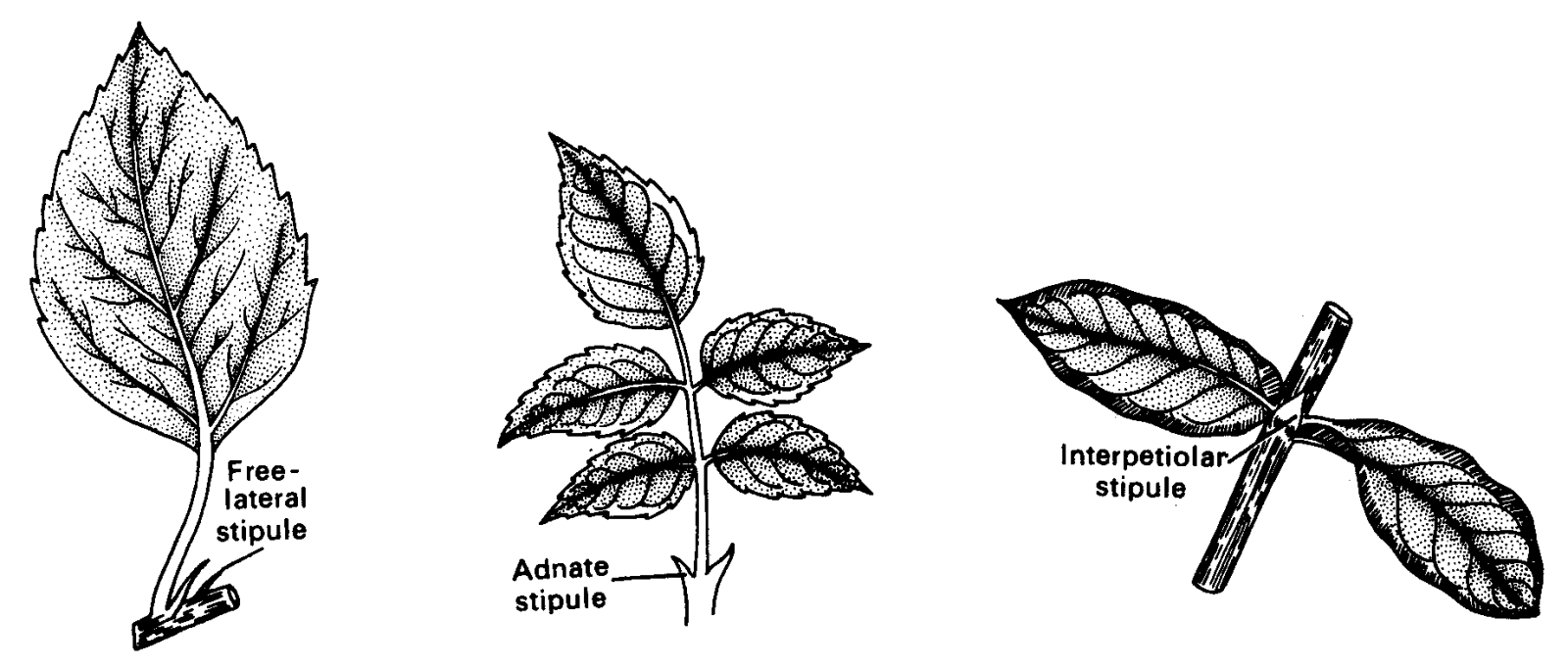
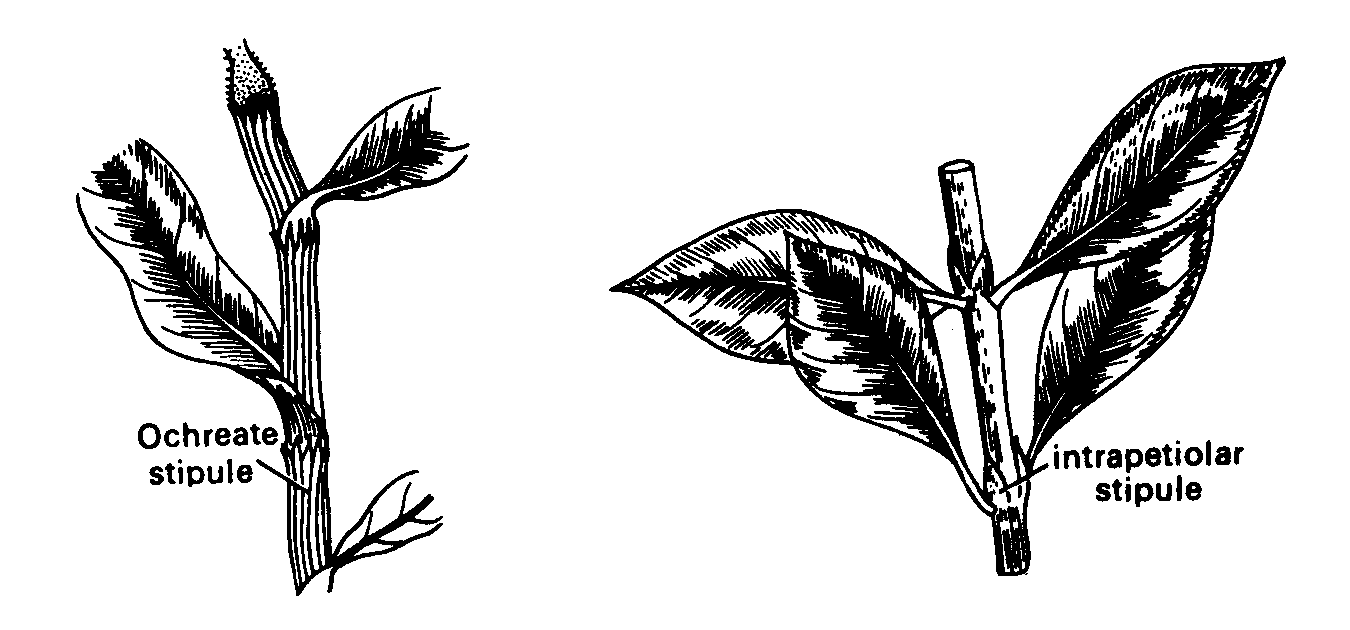
Except free lateral stipules, all are modified because of adhesion or cohesion.
MODIFICATIONS OF STIPULES
To carry on special functions, stipules are modified into following types:
- Foliaceous: Here stipules are modified into large leafy green structures performing all the functions of foliage leaves, e.g., pea, sweat pea, wild pea, Passiflora, Cassia.
- Tendrillar: Here stipules get modified into thin, thread like, coiled structures meant for climbing up, e.g., Smilax.
- Spiny: When stipules become modified into two sharp pointed structures, they are called spiny. Such spinous stipules serve as defensive structures, which may be long e.g. Acacia or curved e.g., Zizyphus, Mimosa, Capparis, Aegle, etc.
- Convolute or bud-scale: They are scaly stipules which enclose and protect the leaf-buds. They fall off as soon as leaves unfold, e.g., Ficus, Artocarpus, Magnolia, Mesua, etc.
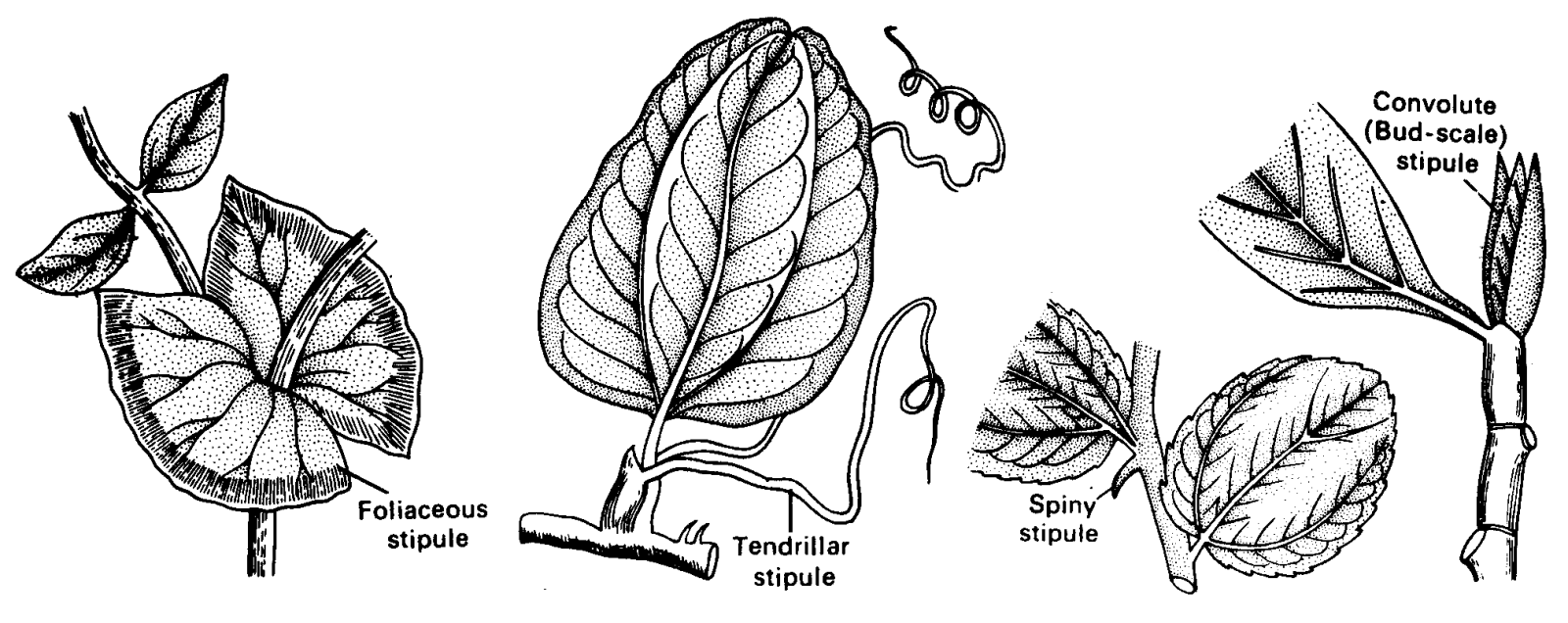
STIPEL
Stipule like appendages found to grow on two sides of the leaflet bases are called stipels. They are regarded by some workers as rudimentary leaflets which failed to develop, e.g., bean (Dolichos lablab), Desmodium, Phaseolus, Clitoria, Vicia, etc.
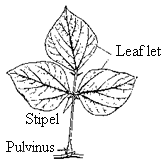
Fig. Stipel
Venation
Veins arise from the mid rib and transverse the leaf lamina in different directions. From each vein many veinlets arise. Veins and veinlets are not only mechanically and physiologically important but also taxonomically significant. The arrangement of veins and veinlets in the lamina is known as venation.
Types OF Venation
There are two main types of venation: reticulate and parallel.
- Reticulate venation: In this type, veins and veinlets arrange to form a reticulum or network. It is a characteristic of dicot leaves, except Calophyllum, Corymbium and Eryngium. On the basis of number of mid ribs, it is of two types:
- Unicostate or pinnate: In this type, there is only one mid rib or costa that gives out many lateral veins which run towards margin or apex of leaf, e.g., mango, banyan, guava, etc.
- Multicostate or palmate: In this type, there are number of more or less equally strong ribs arising from the tip of the petiole which run outwards or upwards. It may be of two types:
- Convergent: All the mid ribs converge towards the tip of the lamina, e.g., Indian plum (Zizyphus jujuba), bay leaf (Cinnamomum tamala), etc.
- Divergent: All the mid ribs diverge towards the margin of lamina, e.g., castor, China rose, cucumber, grape vine, etc.
- Parallel venation: In this type all veins run parallel to each other. Transverse veinlets are unbranched and are parallel to one another. It is the characteristic feature of monocots, except Smilax, Dioscorea and some aroids. It is also of two types:
- Unicostate or pinnate: In this type, there is a single mid rib that gives out many lateral veins which run towards the margins or apex of the leaf e.g., banana, ginger, Canna, etc.
- Multicostate or palmate: In this type, there are a number of mid ribs which run upwards or outwards. It is of two types:
- Convergent: Mid ribs converge at the apex, e.g. grasses, bamboo, maize, wheat, etc.
- Divergent: Mid ribs diverge towards the margin of lamina, e.g., fan palm (Borassus flabellifer).

Reticulate Reticulate Reticulate Parallel Parallel Parallel
unicostate multicostate multicostate unicostate multicostate Multicostate
convergent divergent convergent divergent
Fig. Venation in leaves
Frequently Asked Questions
Ans. In biology, a leaf is a plant organ primarily involved in photosynthesis and transpiration.
Ans. A leaf is the green, flat organ of a plant that typically grows off the stem, responsible for capturing light energy.
Ans. The structure of a leaf includes the blade, petiole, and sometimes stipules, with veins running through it.
Ans. The primary function of a leaf is to perform photosynthesis, converting sunlight into energy for the plant.
Ans. A leaf is important because it produces food for the plant through photosynthesis, enabling growth and survival.
Ans. Characteristics of a leaf include its shape, size, margin, venation, and the presence of structures like petioles and stipules.